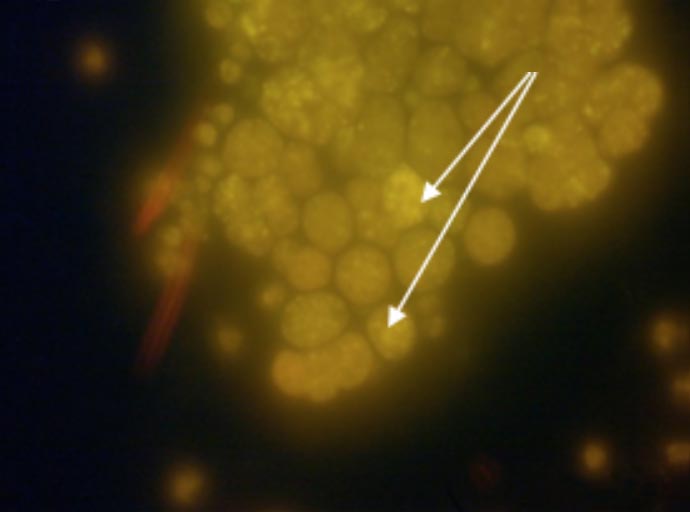We have a new marine protist (a thraustochytrid) which produces high levels of DHA and carotenoids – primarily Beta carotene and canthaxanthin. The organism is flexible in that these outputs can be manipulated. It is commonly thought of as a micro-algae but it is different! It is a new organism but a lot is known about the family that it comes from. A huge amount of safety work on this family of organisms has already been lodged with EFSA (European Food Safety Agency). Patents have been applied for so we believe it is a novel compound. We believe that there is a potential for low manufacturing costs on scale up.
A thraustochytrid is a single-celled, largely marine organism from an ancient group now called the Labyrinthulomycetes or Labyrinthulea. Their closest relatives are currently thought to be brown seaweeds or the oomycetes (water moulds). They are mistakenly now often called micro-algae. The images below show a typical cell with its unique, root-like ectoplasmic net, which stretches out many times the diameter of the cell. This is composed of tubes of unit membrane, while mature cells, particularly in the stationary phase of a culture/fermentation, contain many lipid filled vesicles.


Thraustochytrids are amongst the top known producers of omega-3 fatty acids, especially DHA (docosahexanoic acid) & EPA (eicosapenaenoic acid). They also make carotenoids, squalene (the precursor of many important compounds), external polysaccharides (one with known anti-viral properties), enzymes (some of which can break down tar balls in the sea) and more. Different thraustochytrid isolates makes different ranges of compounds, but for a given type of compound eg fatty acids, the percentage of different fatty acids stays constant whatever the medium. So an isolate producing 60% of its fatty acids as DHA will produce that percentage in a rich or a poor medium. (https://doi.org/10.1007/s10811-017-1149-8 Fossier Marchan et al 2017)
Thraustochytrids are heterotrophs, meaning that they do not require light (and therefore power to produce it) for energy and growth. Thraustochytrids are easily grown in fermenters, which take up far less space than oil seed crops, although their genes have also been engineered into oil-seed plants by the Rothamsted Institute and commercial companies. Oil from these GM plants (grown in fields in Canada) is currently being tested on salmon in Scotland (https://www.thetimes.co.uk/article/feeding-fish-gm-oil-could-boost-health-kl3k0xrck). Freeze dried thraustochytrid cells and oil extracted from them have also been added to food for farmed fish larvae, salmonids and other fish, with positive results. The natural carotenoids and omega-3 fatty acids they produce have also led them to be included in poultry food, with a resulting increase in omega-3s in both meat and eggs (See eg Rhymer et al 2010 https://doi.org/10.3382/ps.2 009-00232). Thraustochytrid isolates with substantial levels of carotenoids have the potential for dual improvement of egg quality and yolk colour (Galasso, Corinaldesi and Sansone (2017) www.mdpi.com/2076-3921/6/4/96/pdf. Carotenoids from Marine Organisms: Biological Functions and Industrial Applications: A Review.)
Thraustochytrids have been grown on a wide range of waste products, such as those from meat production (eg Villarroel Hipp & Rodrigues 2018 https: //doi. org/10. 1016/j.jare. 2018. 01.010 ) bread production, waste glycerol (from biodiesel production), meat production wastes, waste potatoes, barley-based distillery waters etc. DSM, with their new partners Evonik are currently growing a species of a thraustochytrid genus called Schizochytrium on corn syrup. Advertising material from this new joint venture estimates that “1 tonne of “Veramaris” omega oil replaces 60 tonnes of wild-caught fish”.
DHA and EPA and other products from un-genetically engineered Thraustochytrids have been already passed as safe for human consumption, including the highest category – as additives to baby food, by the FDA, the Food Standards Agencies of England and Scotland and the EU (see eg Commission Implementing Decision EU 2015/545.). The oils and other products are being incorporated into animal and human foods and nutraceuticals. Thraustochytrids are also being used to enrich food wastes.